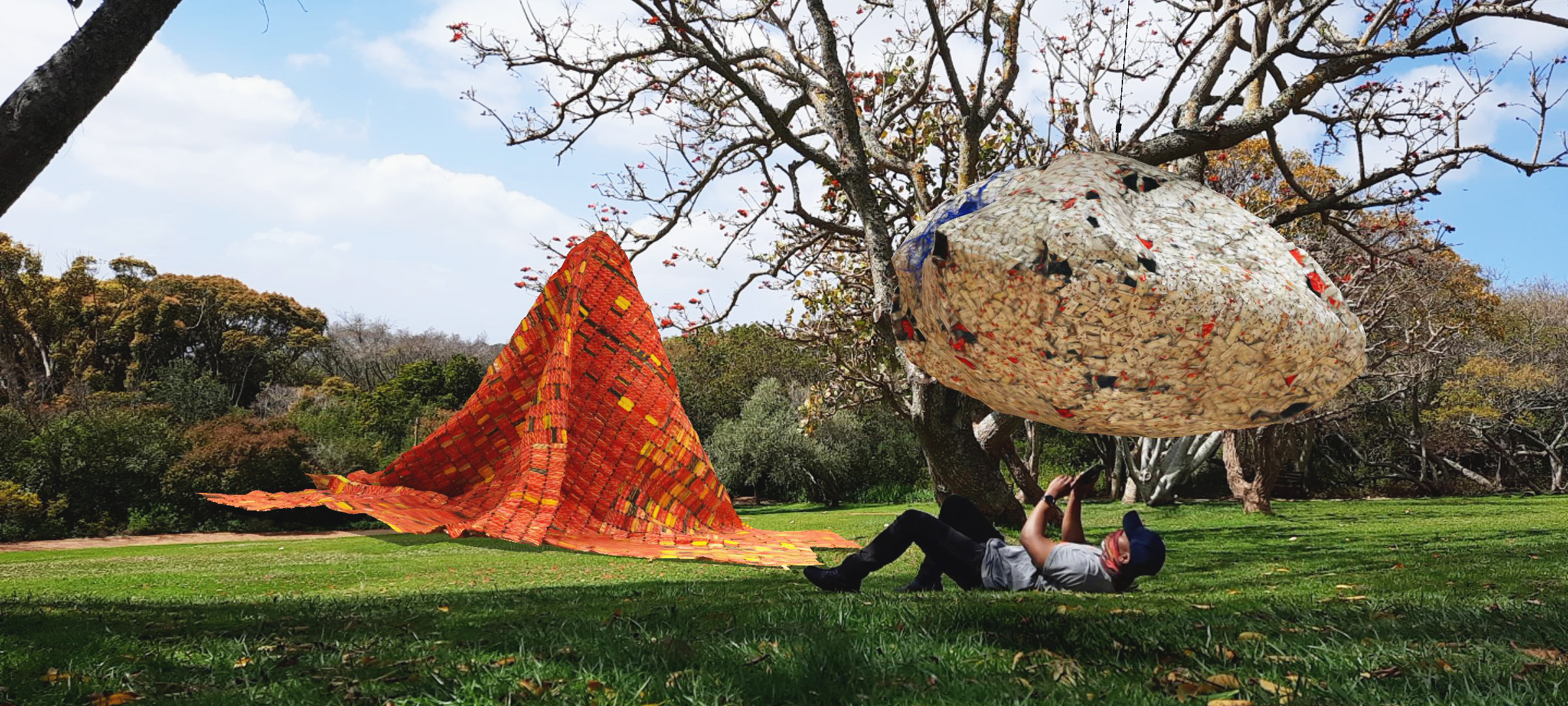Imaginal Renderings: ‘Seeing the Invisible’ in Kirstenbosch Gardens
A review by Lukho Witbooi on the 1st of March 2022 for ArtThrob.
----------------------

Mohammed Kazem, Directions (Zero), 2021
I suspect I spend an average of 24 hours on YouTube a week. It makes me feel like I am plugged into an information matrix, and I can’t tell where my thoughts begin or end. It’s shortly after watching Mark Zuckerberg’s Metaverse announcement that I go to Kirstenbosch Gardens to see an augmented reality contemporary art exhibition called Seeing The Invisible. The exhibition features 13 augmented reality (AR) works by 12 established artists from various countries and is co-curated by Hadas Maor (curator of contemporary art) and Tal Michael Haring (virtual and augmented reality expert and curator). The duality of Seeing The Invisible IN the Kirstenbosch Gardens creates a sense of having stepped into an architectural rendering.

El Anatsui, AG + BA (AR) 2014, 2021
Mohammed Kazem’s Directions (Zero) is a big golden zero that looks like it’s growing from the ground. It looks both real and unreal. It’s like I caught up to a golden rainbow with geographical coordinates of the world’s countries inscribed on its surface. You can go under Directions (Zero) and see its three-dimensional structure, but as your body passes through it, a sense of alienness sticks with you, like the moon has come down to earth in its perceived size or you’ve come across the monolith in 2001: A Space Odyssey. In Directions (Zero), Kazem explores the significance of the number zero – discovered by the Persian scientist Muhammad Ibn Musa Al-Khwarizmi. The artwork is about the origins and connections of all things. Zero is used as a placeholder which connects all humans, as it does for numbers, despite their complexity. By including all the geographical coordinates of all the countries in the world, the artist asks us to acknowledge differences, but also to think about peaceful co-existence.

Ori Gersht, Forget Me Not, 2021
Ori Gersht’s Forget Me Not is based on Brueghel the Elder’s painting Flowers in a Wooden Vessel (1606/7). It is a bouquet of white, red and yellow roses with sunflowers inside a grey base. You come across the artwork in the middle of a stone trail of the Kirstenbosch Gardens, and it’s accompanied by the humming of bees which creates this foreboding feeling. It’s beautiful and awful. Are these flowers for a wedding or a funeral? As you step closer to the artwork, it explodes, sending fragments of smoke, glass, petals, and insects into the air in slow motion like bullets from The Matrix. You can then observe all the details: a beetle in the air or a white flower petal. Take time to appreciate an artwork that links both chaos and order. The symbolism of life and death. The artwork leaves an imaginal impression as I reflect on it later; the phone used to see the invisible has been discarded by the imagination, but the visual impression I experienced remains. The voices of three scholars are also heard: “Scribing the once lush bouquet from a personal point of view, they offer different interpretations of the original painting that disappeared in the folds of time.”
El Anatsui’s iconic bottle-cap installations AG + BA (AR) use the same material, but they create two different installations and experiences. The first artwork is like a red tent on the ground. It’s a beautiful red with bits of yellow. On closer inspection, you can see the bottlecaps sewn together, and the craftsmanship is obvious. So are the folds of its bent shape that are detailed enough to include shadows. There is also a slight breeze, making the artwork move. The craftmanship brings attention to the material used. Anatsui uses thousands of aluminium bottle-tops wired together with copper to make useful and beautiful discarded materials. The other artwork is a silver hanging ball on a blue string. Because it is an AR work, it hangs from the clear sky. It’s like the artist made this artwork and placed it in a fire and removed it as it started shrinking. The piece has holes in it and looks like a bird’s nest or a futuristic treehouse.
El Anatsui’s installations impress the most upon the imagination. Is it because these are acute representations of existing artworks? Yes, what I’ve seen are immaterial objects through a phone, but the detailed craftsmanship and the texture of these works evokes sensations of plastic on the tongue or crushing plastic bags with my hands. It’s clear that in appreciating Seeing The Invisible the visual and audible are not enough and that memories of what we’ve experienced with all our five senses remain potent. This realisation grounds me back to the material. I decide I am going to make time for the aromatic plants of the Kirstenbosch Gardens.
Seeing the Invisible is on show at Kirstenbosch Gardens until August 2022.
Further Reading In Articles
African Artist Directory















